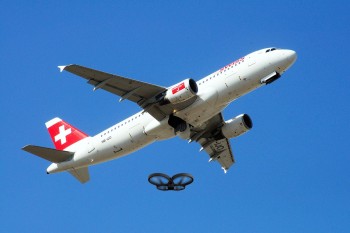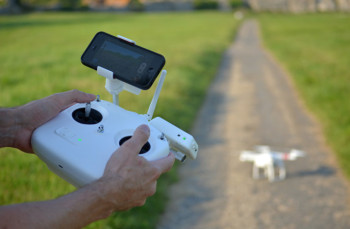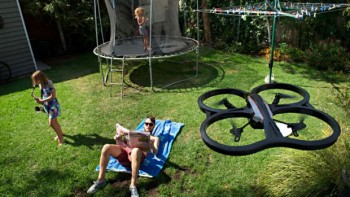As referenced in Part 1 of this post, which can be found here, I’ve been flying Drones for many years, long before the recent surge in popularity. Through my experience I’ve cultivated a strong understanding of drone operations and specifically safety measures. Learn from my mistakes and triumphs.
- Watch the weather
Many drones are advertised to withstand heavy winds, don’t fall for it. While the device may have some capabilities, strong winds can be unpredictable and often cause unintended directions and speeds during flight. Results can be quite dangerous or expensive when you fly in the wind. I typically avoid any wind conditions exceeding 15 miles per hour.

Photo credit: www.adriansommeling.com


Photo credit: dronelife.com
2. Avoid Airports
Never fly within 5 miles of an airport. It’s against the law and can potentially create serious issues. Always check Google maps or whichever outlet you rely upon to insure no airports are within the vicinity of your flight. Furthermore, if you happen to see an airplane nearby, it’s a good idea to lower your drone to safe altitudes.
3. Say NO to sharing (unfortunately)
If someone asks for permission to fly your drone, say no. Unless it’s a trusted individual with whom you are certain has experience flying a drone, do not share your vehicle. Drones can be perceived as a toy and they are a lot of fun, but they are a serious responsibility and handing the controller to an inexperienced pilot is comparable to handing car keys to a drunk driver.
If your friends or family want to learn, start them off with an online simulator or instruct them to purchase an inexpensive drone of their own to practice with.

4. Do not power down your drone in mid-flight
When flying creative patterns such as an “orbit” or “vulture” pattern, the controls often require one control stick to be directed inward and sometimes both sticks to be directed inward. Be very cautious with this input as it’s very similar to the input that powers down your drone. Many drones are capable of being powered off in mid flight with a controller input of both sticks being directed inward and down.
5. Do not use FPV (first person view) goggles
Do not use first person view goggles if you are the pilot. These goggles are a great tool and lots of fun, but they should strictly be worn by a second person for viewing or camera control. The pilot should never obstruct their view or take their eyes off the drone unless it’s for just a few seconds to observe a viewing monitor directly in front them.
Instead of purchasing FPV goggles, I highly recommend picking up a monitor for drone use such as this one. They are an invaluable tool to utilize when flying drones.


6. Say NO to night flights
Do not fly at night. Most drones have lights and can be seen fairly easy against the night sky, but what is commonly overlooked is the absence of visibility for potential obstacles. Power lines become virtually invisible, depth perception is hindered, and obstacles become very difficult to navigate against at night.
7. Don’t over estimate your payload
Never add unintended items to the drone such as something hanging from a string, a counter weight, a sign, a bag for make-shift delivery, etc. Adding additional weight beyond what the drone was designed for can have severe negative effects to the controls and battery life. Stick to cameras and small sensing devices (if applicable) which the drone was designed to support.


7. Steer clear of dense urban areas
Most urban areas are Class B airspace which is heavily regulated and requires permission to fly in. Densely populated urban areas pose a tremendous risk due to tall buildings, potential radio interference, loss of satellite communication, and much more. Strive to keep your drone in the open and uninterrupted skies.
8. Power lines are the enemy
Despite the obvious consequence of running in to a power line and causing major damage, these lines can often emit electrical frequencies that can interfere with the software within a drone. These interference’s can cause erratic controls or power the drone off in mid-flight, thus causing a crash. If you’re in an area with power lines, make every attempt to launch and land your drone away from the power lines.


9. Avoid carbon fiber props
This may go against the grain here a little bit as many Drone operators enjoy using carbon fiber propellers. Carbon fiber is incredibly dense and strong, as a result the movements of the drone can become overly precise and create a bit more difficulty in the controls. Carbon fiber props will also add a bit more speed to your drone, and in all honesty drones are plenty fast enough. Utilize the standard composite propellers such as these and you’ll be just fine. They’re durable and affordable.
Lastly, carbon fiber propellers have proven to be capable of causing significant harm or damage if the unfortunate event occurs that an active and flying drone comes in to contact with something or someone. To put it plainly, carbon fiber props can actually cut off fingers in a split second. Normal plastic/rubber composite props are far safer and will often break a part before causing any sort of harm or damage.
10. Don’t be a creep
One of the very first concerns regarding drone flights when the popular devices first hit the consumer market was privacy. During my first few flights I would get questioned pretty adamantly on concern of privacy. Flying over your neighbors backyard, hovering adjacent to a second story window, spying on another person’s property is essentially the same as trespassing and many states are lobbying for trespassing rights pertaining to drones and their potential crossing the boundary.
Don’t be a creep. Use your drones to capture stunning photography & video such as the examples you see here, or to help better your community with services such as aerial mapping, search and rescue, environmental survey, and much more. Drones have a clear place in many industries, invading privacy is not one of them.
